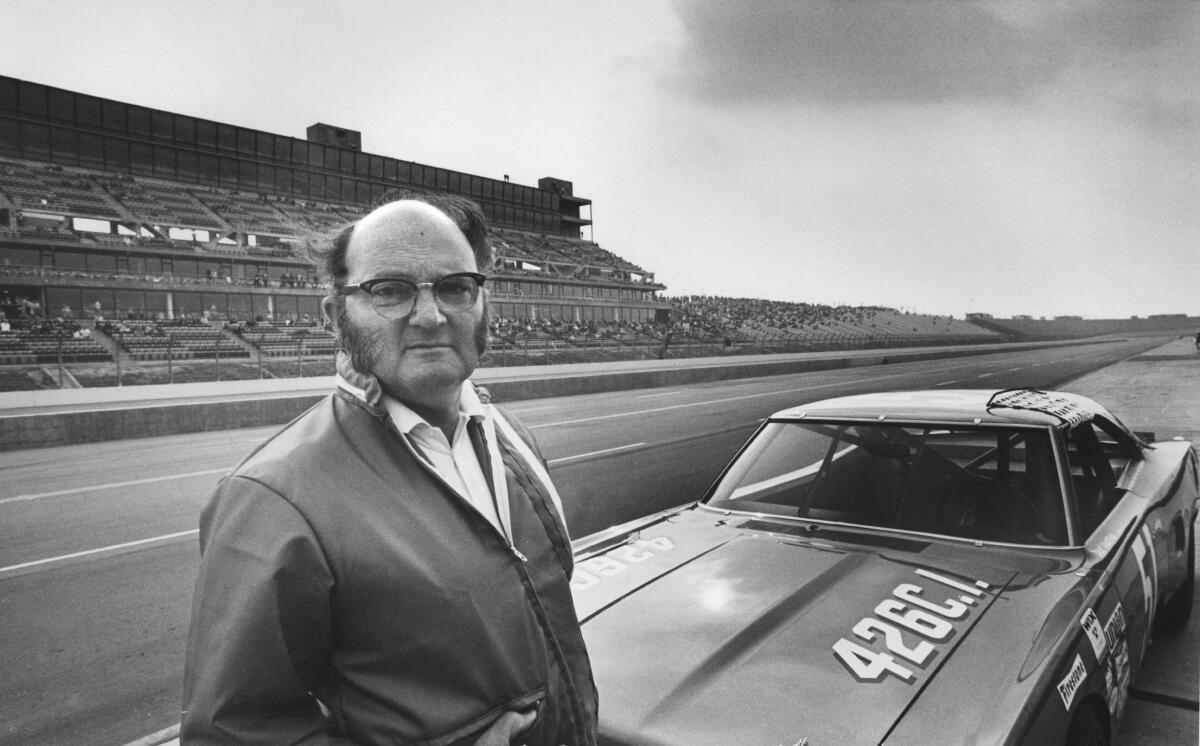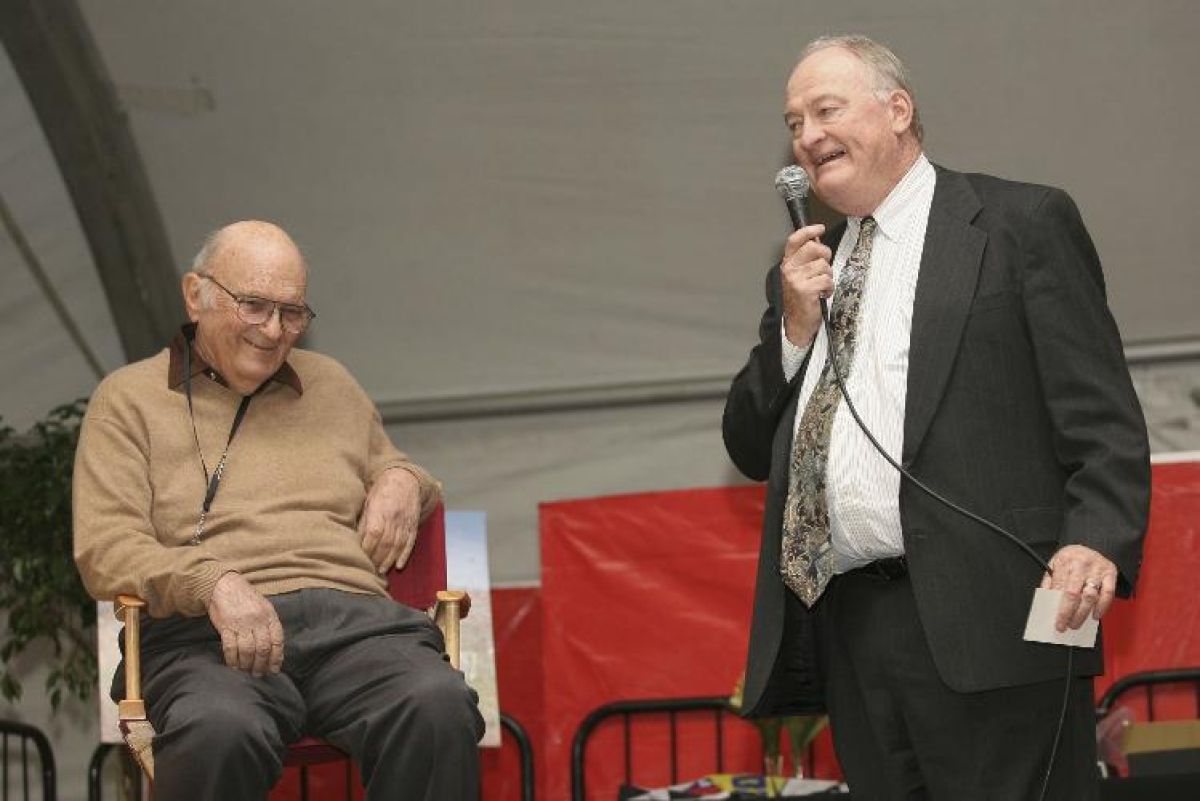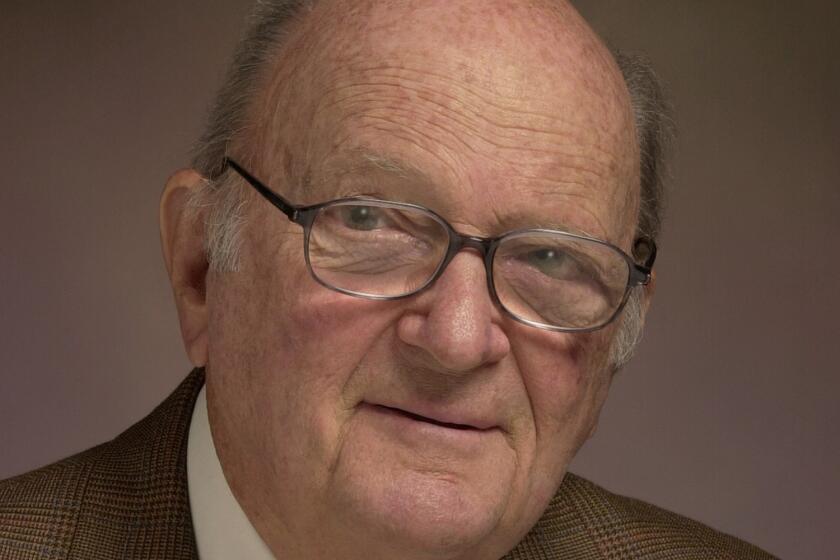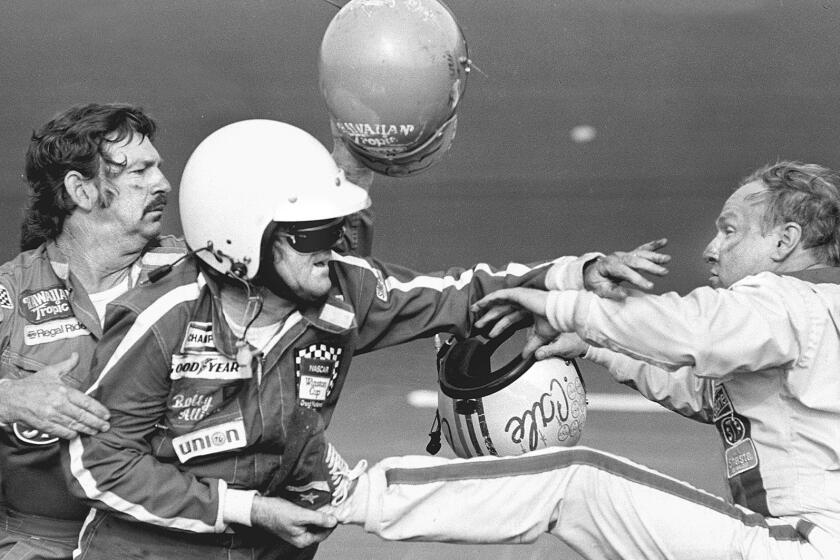Shav Glick, longtime L.A. Times motorsports writer, inducted into NASCAR Hall of Fame

- Share via
The stories he wrote were memorable. The friends he made were boundless. And the awards he’s won, well, they just keep coming even some 16 years after his death.
NASCAR announced on Tuesday that legendary Times motorsports writer Shav Glick has been awarded the Squier-Hall Award for NASCAR Media Excellence. The lifetime achievement honor is named for broadcasters Ken Squier and Barney Hall and is part of the NASCAR Hall of Fame.
“Shav Glick was a giant in motorsports journalism and the racing authority on the West Coast,” said Jim France, NASCAR chairman and chief executive. “For decades, Shav delivered the sport to fans in a highly entertaining and informative manner, while introducing NASCAR to a new audience as the sport grew nationally.
“He had a special way of highlighting the people behind the competition, always showcasing the human element that makes NASCAR so special. Whether he was covering the NASCAR Cup Series or a grassroots-level race, Shav’s professionalism and grace embodied the best of sports journalism.”
Shav Glick, whose insightful coverage of motor sports for The Times made him nearly as famous as the racing stars he chronicled, died Saturday at his Pasadena home of complications from melanoma, said his companion, Doris Syme.
The ceremony will be Jan. 19 in Charlotte, N.C. San Diego’s Jimmie Johnson, Donnie Allison and Chad Knaus will be inducted into the hall and Janet Guthrie will receive the Landmark Award for Outstanding Contributions to NASCAR.
Glick wrote about sports for seven decades before retiring in January 2006. He had his first byline in the Pasadena Post when he was 14. He had his last in The Times when he was 85. He didn’t start covering motorsports until he was 48 when he was tapped to succeed Bob Thomas in 1969.
In between, he covered 35 Indianapolis 500s, 32 Daytona 500s, Formula One races, Grand Prix sports car races and every Long Beach Grand Prix but one. And that doesn’t count the motorcycles, midgets and sprint cars he wrote about.
He died on Oct. 20, 2007, at 87.
In 2004, he was inducted into the Motorsports Hall of Fame. He was the first journalist from a general circulation newspaper to receive that honor.
Glick was also covering golf when he started on the motorsports beat. As the sports calendar started to get more crowded, conflicts arose. He would have to make choices.

“To the astonishment of my golfing friends, I took racing,” Glick would say. “The reason was obvious to me. Racing people are the most interesting I’ve ever worked with.”
And the person he most enjoyed interviewing?
“[Richard] Petty, without a doubt,” Glick wrote in his final story. “Who else would say, when asked about his race plans, ‘I just want to beat one cat in the race. The one that’s second.’ Or, after losing in the last turn, at Daytona, ‘I had one ulcer before the race, now I’ve got two.’ On his nickname, the King: ‘It’s better’n a lot of things I’ve been called.’
“Not only was he quotable, he’d sit and chat as long as your pen or tape recorder held up, signing autographs as he talked. Perhaps the greatest ambassador any sport has had.”
While Glick might have been describing Richard Petty, he was also describing himself.
“Go to any press room at any racetrack in the country and, if he’s there, Glick will be the most popular writer,” Mike Kupper, a former Times assistant sports editor, once wrote about Glick. “Among readers, certainly, for his prose speaks for itself, but even more among other writers and team representatives. There is no end to the line of visitors who ‘need to talk to Shav.’ And he had time for all of them, sometimes while he’s busy writing his story.”
Bill Dwyre, who was Glick’s sports editor from 1981 until Dwyre switched from boss to columnist in 2006, remembers Glick’s perseverance and dedication.
“Irwindale Speedway had a big opening one night,” Dwyre said. “There was practice at 2 p.m. for a 7 p.m. race. I get a call from Shav that some kid turned his car over and was killed. This was 2 p.m. and Shav was there.”

Glick was pretty consistent when asked about his best memories, often saying that his favorite race was the one he was covering and that his favorite character was the one he was interviewing.
But he did disclose some favorites, if prodded, such as his most memorable finish.
“It was the 1992 NASCAR season finale at Atlanta,” Glick wrote in his final story. “Three drivers — Davey Allison, Bill Elliott and Alan Kulwicki — still had shots at the championship. Allison crashed out early, leaving the crown and its $1-million bonus to either Elliott or Kulwicki, whichever led lap 310 in the 328-lap race.
“When Kulwicki sped past a surprised Elliott just before the start-finish line, it meant that the most laps Elliott could lead would be 102. Kulwicki had 103, enough for a five-point bonus. That was the difference in the championship after Kulwicki finished second to Elliott in the race. If Elliott had led that lap, they would have tied in points and Elliott had the tiebreaker, five wins to two.”
On the verge of a long-deserved but somewhat feared retirement, it was a testament to Glick’s command of the sport that he would not pick the last lap of a race, but one near the end as his most memorable.
Popular vote takes on new meaning as veteran Times staffer will be honored this summer
He was clear, though, that his favorite story was an award-winner about Junior Johnson and how he evolved from moonshine bootlegger to stock car driver. While on the surface it was a story about a singular character, Glick’s writing made it an allegory on the start and evolution of NASCAR racing.
“Beneath thick stands of Carolina pine, past the sheds where the coon dogs howl, a brook tumbles out of the Brushy Mountains bringing a refreshing coolness to the meadows of Ingle Hollow,” Glick wrote.
“The brook is nameless.
“’It’s just a little ol’ stream,’ says the owner of the meadows. ‘Don’t recall it ever havin’ a name or nuthin’.
“The brook deserves better. It and hundreds of other rivulets draining the Piedmont region of North Carolina should have historical markers that read:
“’Here Lie the Headwaters of American Stock Car Racing.”
Dwyre also remembers accompanying Glick to a drag race at Pomona Speedway. As they approached the entrance, Glick had trouble finding his credential for getting into the press box.
With four simple words, a sport that was born out of bootlegging, good ole boys and fast cars graduated from a regional sideshow to a national spectacle.
“He was stopped and was still fumbling around to find his badge,” Dwyre said. “When the guy insisted on seeing a credential, Shav just pointed to the sign, ‘Well, the press box is named for me.’”
Dwyre golfed with Glick about a month before he died.
“We were at Brookside,” Dwyre said. “It was after he received the diagnosis that he had cancer in his shoulder. He said that the doctors told him that they could operate but he would never be able to play golf again. He said, ‘Forget about it.’ He was tiring that day and skipped a couple holes near the end.
“But on the 18th hole, he made a 40-foot putt. He never hit another shot.”
And now, many years later, he has been given yet another finish to a remarkable story.
More to Read
Go beyond the scoreboard
Get the latest on L.A.'s teams in the daily Sports Report newsletter.
You may occasionally receive promotional content from the Los Angeles Times.













